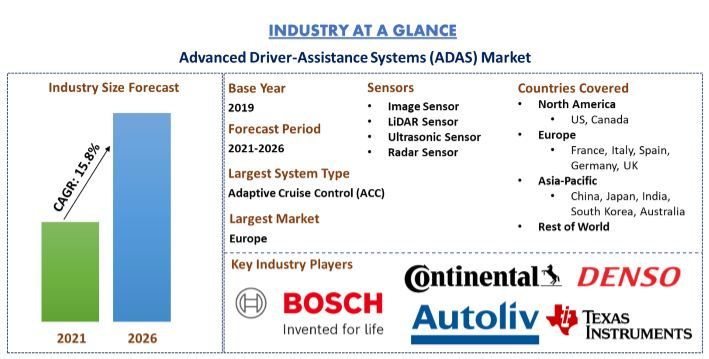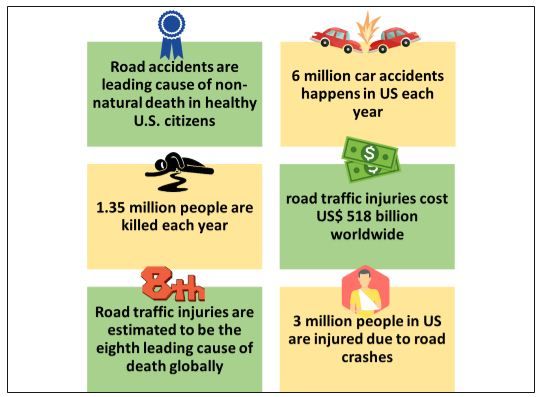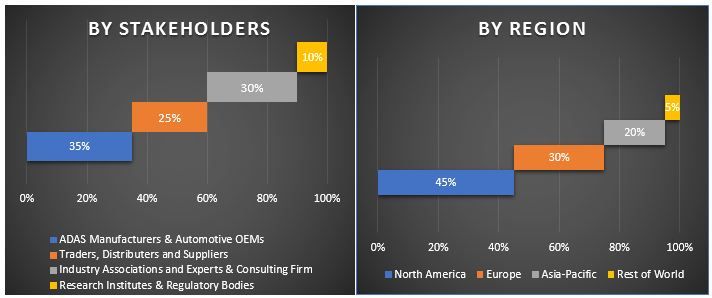- Trang chủ
- Về chúng tôi
- Ngành
- Dịch vụ
- Đọc
- Liên hệ với chúng tôi
Thị trường Hệ thống Hỗ trợ Lái xe Tiên tiến (ADAS): Phân tích Hiện tại và Dự báo (2020-2026)
Nhấn mạnh vào Loại Hệ thống (Kiểm soát Hành trình Thích ứng (ACC), Hỗ trợ Đỗ xe Thông minh (IPA), Phanh Khẩn cấp Tự động (AEB), Đèn Pha Thích ứng (AFL), Phát hiện Điểm mù (BSD), Cảnh báo Lệch làn đường (LDW), Hệ thống Giám sát Tình trạng Buồn ngủ (DMS), Loại khác), Loại Cảm biến (Cảm biến Hình ảnh, Cảm biến LiDAR, Cảm biến Siêu âm, Cảm biến Radar, Loại khác), Loại Xe (Xe chở khách, Xe thương mại hạng nhẹ, Xe thương mại hạng nặng), Kênh Phân phối (Nhà sản xuất Thiết bị Gốc (OEMs), Thị trường phụ tùng) và Khu vực/Quốc gia
Hệ thống hỗ trợ lái xe nâng cao (ADAS) tập trung vào việc giảm thiểu tai nạn giao thông và các thương vong liên quan bằng cách giúp người lái xe tránh hoàn toàn va chạm. Các hệ thống này phản ứng nhanh hơn bất kỳ người nào, luôn cảnh giác và đã được chấp nhận và triển khai trên nhiều phân khúc xe khác nhau, từ các mẫu xe cao cấp đến phổ thông. Hệ thống ADAS liên tục theo dõi môi trường xung quanh xe, cảnh báo người lái xe về các điều kiện đường xá nguy hiểm và thực hiện các hành động khắc phục, chẳng hạn như giảm tốc độ hoặc dừng xe.
Nhu cầu về hệ thống hỗ trợ lái xe nâng cao (ADAS) giúp giám sát, cảnh báo, phanh và điều khiển lái được dự đoán sẽ sớm tăng lên, phần lớn là do sự quan tâm của các cơ quan quản lý và người tiêu dùng đối với các ứng dụng an toàn nhằm bảo vệ người lái xe và giảm tai nạn. Ví dụ, cả Liên minh Châu Âu và Hoa Kỳ đều yêu cầu tất cả các xe phải được trang bị hệ thống phanh khẩn cấp tự động và hệ thống cảnh báo va chạm phía trước vào năm 2020.
Nhiều công ty bán dẫn trước đây không tham gia vào lĩnh vực ô tô hiện đang cung cấp hoặc phát triển các sản phẩm ADAS. Các nhà sản xuất ô tô đã đưa ra tên công nghệ mang thương hiệu riêng của họ, ví dụ, đã tạo ra hai mươi tên duy nhất cho hệ thống kiểm soát hành trình thích ứng và mười chín tên khác nhau cho hệ thống hỗ trợ giữ làn đường. Ngoài việc có sẵn rộng rãi, chi phí của các tính năng hỗ trợ lái xe tương đối phải chăng. Ví dụ: giá trung bình của hệ thống kiểm soát hành trình thích ứng là 1.174 đô la Mỹ như một tính năng độc lập và 2.283 đô la Mỹ trong một gói ADAS. Chi phí của một gói ADAS trung bình vào khoảng 1.950 đô la Mỹ theo dữ liệu của SBD. Chi phí trung bình cho một chiếc xe mới vào tháng 12 năm 2017, theo báo cáo của Kelley Blue Book, là 36.113 đô la Mỹ. Điều này làm cho chi phí của một gói ADAS chiếm khoảng 5,4% tổng chi phí của xe. Các tính năng ADAS phổ biến như Kiểm soát hành trình thích ứng, Cảnh báo điểm mù và Phanh khẩn cấp tự động có sẵn trên ít nhất 80% các xe trong mỗi phân khúc xe cỡ trung, cỡ lớn và SUV. Hỗ trợ giữ làn đường có sẵn trên ít nhất 60% xe trong 7 trên 10 phân khúc xe. Các tính năng này đang trở thành trang bị tiêu chuẩn trên nhiều xe. Ví dụ: Phanh khẩn cấp tự động là tiêu chuẩn trên 30,6% của tất cả các mẫu xe, Hỗ trợ giữ làn đường trên 13,9% và Kiểm soát hành trình thích ứng trên 11,8%.
Gánh nặng thương tích do tai nạn giao thông mỗi năm
Robert Bosch GmbH, Continental AG, Autoliv Inc., Aptiv, Delphi Automotive Company, ZF Friedrichshafen, Denso Corporation, Hella KGAA Hueck & Co, Hyundai Mobis và Texas Instruments Inc là một số nhà sản xuất nổi bật đang hoạt động trên thị trường Hệ thống hỗ trợ lái xe nâng cao toàn cầu. Một số hoạt động M&A cùng với quan hệ đối tác đã được thực hiện bởi các nhà sản xuất này để tạo điều kiện cho khách hàng với các sản phẩm công nghệ cao và sáng tạo.
Thông tin chi tiết được trình bày trong báo cáo
“Trong số các loại hệ thống, phân khúc kiểm soát hành trình thích ứng chiếm phần lớn thị phần”
Dựa trên loại hệ thống, thị trường được chia thành Kiểm soát hành trình thích ứng (ACC), Hỗ trợ đỗ xe thông minh (IPA), Phanh khẩn cấp tự động (AEB), Đèn pha trước thích ứng (AFL), Phát hiện điểm mù (BSD), Cảnh báo lệch làn đường (LDW), Hệ thống giám sát buồn ngủ (DMS) và các loại khác. Phân khúc hỗ trợ đỗ xe thông minh chiếm lĩnh thị trường với thị phần 27,4% vào năm 2019 và dự kiến sẽ duy trì sự thống trị của mình trong giai đoạn dự báo do sự ưa thích của người tiêu dùng đối với sự thoải mái và sang trọng, và sự cạnh tranh gia tăng giữa các OEM để cung cấp các tính năng hỗ trợ lái xe như vậy.
“Trong số các loại cảm biến, cảm biến hình ảnh dự kiến sẽ chiếm lĩnh thị trường trong giai đoạn được phân tích”
Dựa trên phân khúc thị trường theo loại cảm biến, thị trường được chia thành Cảm biến hình ảnh, Cảm biến LiDAR, Cảm biến siêu âm, Cảm biến radar và các loại khác. Năm 2019, Cảm biến hình ảnh chiếm 35,9% thị phần doanh thu. Hiện tại, cảm biến hình ảnh chiếm lĩnh thị trường Hệ thống hỗ trợ lái xe nâng cao và dự kiến sẽ duy trì sự thống trị trong giai đoạn được phân tích. Các cảm biến hình ảnh cung cấp các tính năng an toàn nâng cao trên đường bằng cách cung cấp các tính năng như hỗ trợ đỗ xe, cảnh báo lệch làn đường và hệ thống tránh va chạm.
“Trong số các loại xe, xe chở khách dự kiến sẽ chiếm lĩnh thị trường trong giai đoạn được phân tích”
Dựa trên phân khúc thị trường theo loại xe, thị trường được chia thành xe chở khách, xe thương mại hạng nhẹ và xe thương mại hạng nặng. Năm 2019, xe chở khách chiếm thị phần lớn nhất với 52,8% và dự kiến sẽ là phân khúc hàng đầu của thị trường Hệ thống hỗ trợ lái xe nâng cao trong giai đoạn dự báo. Các công nghệ mới trong xe đang được phát triển có khả năng làm tăng cũng như giảm nguy cơ thương tích do tai nạn bằng cách gây xao nhãng cho người lái xe và thay đổi hành vi vô tình. Các tính năng ADAS phổ biến có sẵn trên ít nhất 60-80% xe trong các phân khúc xe cỡ trung, cỡ lớn và SUV khác nhau.
“Trong số các kênh phân phối, OEM dự kiến sẽ chiếm lĩnh thị trường trong giai đoạn được phân tích”
Dựa trên phân khúc thị trường theo kênh phân phối, thị trường được chia thành OEM và thị trường phụ tùng thay thế. Năm 2019, các OEM chiếm thị phần lớn nhất với 79,1% và dự kiến sẽ dẫn đầu trong suốt giai đoạn dự báo. Các công ty ô tô hiện đang phát triển các loại xe mới, hệ thống truyền động điện, công nghệ tự hành và hệ thống an toàn tiên tiến với tốc độ chưa từng có. Các nhà sản xuất thiết bị gốc (OEM) và các nhà cung cấp của họ nhận ra rằng cuối cùng họ có thể trở thành tính năng chính để phân biệt các thương hiệu ô tô, cũng như một trong những nguồn doanh thu quan trọng nhất của họ.
“Bắc Mỹ đại diện cho một trong những thị trường lớn nhất của thị trường Hệ thống hỗ trợ lái xe nâng cao”
Để hiểu rõ hơn về động lực thị trường của thị trường Hệ thống hỗ trợ lái xe nâng cao, một phân tích chi tiết đã được thực hiện cho các khu vực khác nhau trên toàn cầu bao gồm Bắc Mỹ (Hoa Kỳ, Canada và Phần còn lại của Bắc Mỹ), Châu Âu (Đức, Pháp, Ý, Tây Ban Nha, Vương quốc Anh và Phần còn lại của Châu Âu), Châu Á-Thái Bình Dương (Trung Quốc, Nhật Bản, Ấn Độ, Úc và Phần còn lại của Châu Á-Thái Bình Dương) và Phần còn lại của Thế giới đã được thực hiện. Châu Âu chiếm lĩnh thị trường và tạo ra doanh thu 11,3 tỷ đô la Mỹ vào năm 2019. Triển vọng tăng trưởng thị trường là do sự hiện diện của các nhà sản xuất ô tô lớn nhất thế giới trên toàn thế giới. Tuy nhiên, khu vực Châu Á-Thái Bình Dương dự kiến sẽ chứng kiến mức tăng trưởng CAGR cao nhất là 18,52% trong giai đoạn dự báo 2021-2026.
Lý do nên mua báo cáo này:
- Nghiên cứu bao gồm phân tích định cỡ thị trường và dự báo được xác thực bởi các chuyên gia hàng đầu trong ngành được xác thực
- Báo cáo trình bày một đánh giá nhanh về hiệu suất tổng thể của ngành trong nháy mắt
- Báo cáo bao gồm phân tích chuyên sâu về các đồng nghiệp nổi bật trong ngành với trọng tâm chính vào tài chính kinh doanh chính, danh mục sản phẩm, chiến lược mở rộng và các phát triển gần đây
- Xem xét chi tiết các động lực, hạn chế, xu hướng chính và cơ hội hiện có trong ngành
- Nghiên cứu bao gồm toàn diện thị trường trên các phân khúc khác nhau
- Phân tích sâu sắc ở cấp độ khu vực của ngành
Tùy chọn tùy chỉnh:
Thị trường Hệ thống hỗ trợ lái xe nâng cao có thể được tùy chỉnh thêm theo yêu cầu hoặc bất kỳ phân khúc thị trường nào khác. Bên cạnh đó, UMI hiểu rằng bạn có thể có nhu cầu kinh doanh riêng của mình, do đó hãy thoải mái kết nối với chúng tôi để nhận một báo cáo hoàn toàn phù hợp với yêu cầu của bạn.
Mục lục
Phân tích thị trường lịch sử, ước tính thị trường hiện tại và dự báo thị trường tương lai của Thị trường Hệ thống Hỗ trợ Lái xe Tiên tiến Toàn cầu là ba bước chính được thực hiện để tạo và phân tích việc áp dụng Hệ thống Hỗ trợ Lái xe Tiên tiến trong ngành công nghiệp ô tô ở các khu vực chính trên toàn cầu. Nghiên cứu thứ cấp toàn diện đã được tiến hành để thu thập các số liệu thị trường lịch sử và ước tính quy mô thị trường hiện tại. Thứ hai, để xác thực những thông tin chi tiết này, nhiều phát hiện và giả định đã được xem xét. Hơn nữa, các cuộc phỏng vấn sơ cấp toàn diện cũng đã được thực hiện với các chuyên gia trong ngành trên toàn bộ chuỗi giá trị của lĩnh vực Hệ thống Hỗ trợ Lái xe Tiên tiến. Sau khi giả định và xác thực các số liệu thị trường thông qua các cuộc phỏng vấn sơ cấp, chúng tôi đã sử dụng phương pháp tiếp cận từ trên xuống để dự báo quy mô thị trường hoàn chỉnh. Sau đó, các phương pháp phân tích thị trường và phương pháp tam giác dữ liệu đã được áp dụng để ước tính và phân tích quy mô thị trường của các phân khúc và phân đoạn phụ mà ngành liên quan đến. Phương pháp luận chi tiết được giải thích dưới đây:
Phân tích Quy mô Thị trường Lịch sử
Bước 1: Nghiên cứu Chuyên sâu về các Nguồn Thứ cấp:
Nghiên cứu thứ cấp chi tiết đã được thực hiện để có được quy mô thị trường lịch sử của Hệ thống Hỗ trợ Lái xe Tiên tiến thông qua các nguồn nội bộ của công ty như báo cáo thường niên & báo cáo tài chính, các bài thuyết trình về hiệu suất, thông cáo báo chí, v.v., và các nguồn bên ngoài bao gồm tạp chí, tin tức & bài viết, ấn phẩm của chính phủ, ấn phẩm của đối thủ cạnh tranh, báo cáo ngành, cơ sở dữ liệu của bên thứ ba và các ấn phẩm đáng tin cậy khác.
Bước 2: Phân khúc Thị trường:
Sau khi có được quy mô thị trường lịch sử của thị trường Hệ thống Hỗ trợ Lái xe Tiên tiến, chúng tôi đã tiến hành phân tích thứ cấp chi tiết để thu thập thông tin chi tiết về thị trường lịch sử và chia sẻ cho các phân khúc & phân đoạn phụ khác nhau cho các khu vực chính. Các phân khúc chính được bao gồm trong báo cáo như loại hệ thống, loại cảm biến, loại xe và kênh phân phối. Các phân tích cấp quốc gia sâu hơn đã được thực hiện để đánh giá việc áp dụng tổng thể Hệ thống Hỗ trợ Lái xe Tiên tiến ở khu vực đó.
Bước 3: Phân tích Yếu tố:
Sau khi có được quy mô thị trường lịch sử của các phân khúc và phân đoạn phụ khác nhau, chúng tôi đã tiến hành phân tích yếu tố chi tiết để ước tính quy mô thị trường hiện tại của Hệ thống Hỗ trợ Lái xe Tiên tiến. Hơn nữa, chúng tôi đã tiến hành phân tích yếu tố bằng cách sử dụng các biến phụ thuộc và độc lập như nhu cầu ngày càng tăng đối với việc lái xe an toàn, hiệu quả và tiện lợi, các quy định của chính phủ về an toàn xe, v.v. Một phân tích kỹ lưỡng đã được thực hiện cho kịch bản cung và cầu, xem xét các quan hệ đối tác hàng đầu, sáp nhập và mua lại, mở rộng kinh doanh và ra mắt sản phẩm trong ngành Hệ thống Hỗ trợ Lái xe Tiên tiến trên toàn cầu.
Ước tính & Dự báo Quy mô Thị trường Hiện tại
Định cỡ Thị trường Hiện tại: Dựa trên những hiểu biết sâu sắc có thể hành động từ 3 bước trên, chúng tôi đã đạt được quy mô thị trường hiện tại, những người chơi chính trong thị trường Hệ thống Hỗ trợ Lái xe Tiên tiến và thị phần của các phân khúc. Tất cả các phần trăm cổ phần, chia tách và phân tích thị trường cần thiết đã được xác định bằng cách sử dụng phương pháp thứ cấp đã đề cập ở trên và đã được xác minh thông qua các cuộc phỏng vấn sơ cấp.
Ước tính & Dự báo: Để ước tính và dự báo thị trường, trọng số đã được gán cho các yếu tố khác nhau bao gồm các động lực & xu hướng, hạn chế và cơ hội có sẵn cho các bên liên quan. Sau khi phân tích các yếu tố này, các kỹ thuật dự báo phù hợp, tức là phương pháp tiếp cận từ trên xuống, đã được áp dụng để đưa ra dự báo thị trường khoảng năm 2026 cho các phân khúc và phân đoạn phụ khác nhau trên các thị trường lớn trên toàn cầu. Phương pháp nghiên cứu được áp dụng để ước tính quy mô thị trường bao gồm:
- Quy mô thị trường của ngành, về giá trị (US$) và tỷ lệ áp dụng Hệ thống Hỗ trợ Lái xe Tiên tiến trên các thị trường lớn trong nước
- Tất cả các phần trăm cổ phần, chia tách và phân tích của các phân khúc và phân đoạn phụ của thị trường
- Những người chơi chính trên thị trường Hệ thống Hỗ trợ Lái xe Tiên tiến về các dịch vụ được cung cấp. Ngoài ra, các chiến lược tăng trưởng được những người chơi này áp dụng để cạnh tranh trong thị trường đang phát triển nhanh chóng
Xác thực Quy mô và Thị phần Thị trường
Nghiên cứu Sơ cấp: Các cuộc phỏng vấn chuyên sâu đã được thực hiện với những Người có Ý kiến Chủ chốt (KOL) bao gồm các Giám đốc điều hành Cấp cao nhất (CXO/VP, Trưởng phòng Kinh doanh, Trưởng phòng Tiếp thị, Trưởng phòng Vận hành và Trưởng khu vực, Trưởng quốc gia, v.v.) trên khắp các khu vực chính. Các phát hiện nghiên cứu sơ cấp sau đó đã được tóm tắt và phân tích thống kê đã được thực hiện để chứng minh giả thuyết đã nêu. Thông tin đầu vào từ nghiên cứu sơ cấp đã được hợp nhất với các phát hiện thứ cấp, do đó biến thông tin thành những hiểu biết sâu sắc có thể hành động.
Phân chia Người tham gia Sơ cấp ở các Khu vực Khác nhau
Kỹ thuật Thị trường
Kỹ thuật tam giác dữ liệu đã được sử dụng để hoàn thành việc ước tính thị trường tổng thể và đưa ra các số liệu thống kê chính xác của từng phân khúc và phân đoạn phụ của thị trường Hệ thống Hỗ trợ Lái xe Tiên tiến. Dữ liệu đã được chia thành nhiều phân khúc & phân đoạn phụ sau khi nghiên cứu các thông số và xu hướng khác nhau trong các lĩnh vực loại hệ thống, loại cảm biến, loại xe và kênh phân phối của thị trường Hệ thống Hỗ trợ Lái xe Tiên tiến.
Mục tiêu chính của Nghiên cứu Thị trường Hệ thống Hỗ trợ Lái xe Tiên tiến
Các xu hướng thị trường hiện tại & tương lai của Hệ thống Hỗ trợ Lái xe Tiên tiến đã được xác định rõ trong nghiên cứu. Các nhà đầu tư có thể thu được những hiểu biết sâu sắc về chiến lược để làm cơ sở cho quyết định đầu tư của họ từ phân tích định tính và định lượng được thực hiện trong nghiên cứu. Các xu hướng thị trường hiện tại và tương lai đã xác định mức độ hấp dẫn tổng thể của thị trường ở cấp khu vực, cung cấp một nền tảng cho người tham gia công nghiệp khai thác thị trường chưa được khai thác để hưởng lợi với tư cách là người tiên phong. Các mục tiêu định lượng khác của các nghiên cứu bao gồm:
- Phân tích quy mô thị trường hiện tại và dự báo của Hệ thống Hỗ trợ Lái xe Tiên tiến về giá trị (US$). Ngoài ra, hãy phân tích quy mô thị trường hiện tại và dự báo của các phân khúc và phân đoạn phụ khác nhau
- Các phân khúc trong nghiên cứu bao gồm các lĩnh vực loại hệ thống, loại cảm biến, loại xe và kênh phân phối
- Xác định và phân tích khuôn khổ pháp lý cho lĩnh vực Hệ thống Hỗ trợ Lái xe Tiên tiến
- Phân tích chuỗi giá trị liên quan đến sự hiện diện của các trung gian khác nhau, cùng với việc phân tích hành vi của khách hàng và đối thủ cạnh tranh của ngành
- Phân tích quy mô thị trường hiện tại và dự báo của thị trường Hệ thống Hỗ trợ Lái xe Tiên tiến cho khu vực chính
- Các khu vực chính được nghiên cứu trong báo cáo bao gồm Bắc Mỹ (Hoa Kỳ và Canada), Châu Âu (Đức, Pháp, Ý, Tây Ban Nha và Vương quốc Anh), Châu Á-Thái Bình Dương (Trung Quốc, Nhật Bản, Ấn Độ, Hàn Quốc và Úc) và Phần còn lại của Thế giới
- Hồ sơ công ty của thị trường Hệ thống Hỗ trợ Lái xe Tiên tiến và các chiến lược tăng trưởng được những người chơi trên thị trường áp dụng để duy trì trong thị trường đang phát triển nhanh chóng Phân tích cấp khu vực chuyên sâu về ngành
Liên quan Báo cáo
Khách hàng đã mua mặt hàng này cũng đã mua













